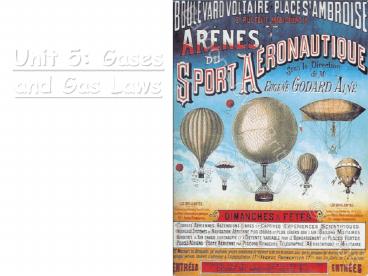Unit 5: Gases and Gas Laws - PowerPoint PPT Presentation
Title:
Unit 5: Gases and Gas Laws
Description:
Unit 5: Gases and Gas Laws Kinetic Molecular Theory Particles of matter are ALWAYS in motion Volume of individual particles is zero. Collisions of particles with ... – PowerPoint PPT presentation
Number of Views:635
Avg rating:3.0/5.0
Title: Unit 5: Gases and Gas Laws
1
Unit 5 Gasesand Gas Laws
2
Kinetic Molecular Theory
- Particles of matter are ALWAYS in motion
- Volume of individual particles is ? zero.
- Collisions of particles with container walls
cause pressure exerted by gas. - Particles exert no forces on each other.
- Average kinetic energy µ Kelvin
temperature of a gas.
3
The Meaning of Temperature
- Kelvin temperature is an index of the random
motions of gas particles (higher T means greater
motion.)
4
Kinetic Energy of Gas Particles
At the same conditions of temperature, all gases
have the same average kinetic energy.
5
Ideal Gases
Ideal gases are imaginary gases that perfectly
fit all of the assumptions of the kinetic
molecular theory.
- Gases consist of tiny particles that are far
apart - relative to their size.
- Collisions between gas particles and between
- particles and the walls of the container are
- elastic collisions
- No kinetic energy is lost in elastic
- collisions
6
Ideal Gases (continued)
- Gas particles are in constant, rapid motion.
They - therefore possess kinetic energy, the energy
of - motion
- There are no forces of attraction between gas
- particles
- The average kinetic energy of gas particles
- depends on temperature, not on the identity
- of the particle.
7
The Nature of Gases
- Gases expand to fill their containers
- Gases are fluid they flow
- Gases have low density
- 1/1000 the density of the equivalent liquid or
solid - Gases are compressible
- Gases effuse and diffuse
8
Diffusion
Diffusion describes the mixing of gases. The
rate of diffusion is the rate of gas mixing.
9
Pressure
- Is caused by the collisions of molecules with
the walls of a container - is equal to force/unit area
- SI units Newton/meter2 1 Pascal (Pa)
- 1 standard atmosphere 101,325 Pa
- 1 standard atmosphere 1 atm
- 760 mm Hg 760 torr
10
Measuring Pressure
The first device for measuring atmospheric
pressure was developed by Evangelista Torricelli
during the 17th century.
The device was called a barometer
- Baro weight
- Meter measure
11
An Early Barometer
The normal pressure due to the atmosphere at sea
level can support a column of mercury that is
760 mm high.
12
The Aneroid Barometer
13
Converting Celsius to Kelvin
Gas law problems involving temperature require
that the temperature be in KELVINS!
Kelvins ?C 273
C Kelvins - 273
14
Standard Temperature and PressureSTP
- P 1 atmosphere, 760 torr
- T 0C, 273 Kelvins
- The molar volume of an ideal gas is 22.42
liters at STP
15
Boyles Law
Pressure is inversely proportional to volume
when temperature is held constant.
- Pressure Volume Constant
- P1V1 P2V2 (T constant)
16
A Graph of Boyles Law
17
Why Dont I Get a Constant Value for PV k?
- Air is not made
- of ideal gases
2. Real gases deviate from ideal behavior at
high pressure
18
Charless Law
- The volume of a gas is directly proportional to
temperature, and extrapolates to zero at zero
Kelvin. - (P constant)
Temperature MUST be in KELVINS!
19
Gay Lussacs Law
The pressure and temperature of a gas are
directly related, provided that the volume
remains constant.
Temperature MUST be in KELVINS!
20
The Combined Gas Law
The combined gas law expresses the relationship
between pressure, volume and temperature of a
fixed amount of gas.
Temperature MUST be in KELVINS!
21
Daltons Law of Partial Pressures
For a mixture of gases in a container, PTotal
P1 P2 P3 . . .
This is particularly useful in calculating the
pressure of gases collected over water.
22
Standard Molar Volume
Equal volumes of all gases at the same
temperature and pressure contain the same number
of molecules. - Amedeo Avogadro
23
Standard Molar Volume
24
Avogadros Law
- For a gas at constant temperature and pressure,
the volume is directly proportional to the number
of moles of gas (at low pressures). - V an
- a proportionality constant
- V volume of the gas
- n number of moles of gas
25
Ideal Gas Law
- PV nRT
- P pressure in atm
- V volume in liters
- n moles
- R proportionality constant
- 0.08206 L atm/ molK
- T temperature in Kelvins
Holds closely at P lt 1 atm
26
Gas Density
so at STP
27
Density and the Ideal Gas Law
Combining the formula for density with the Ideal
Gas law, substituting and rearranging
algebraically
M Molar Mass P Pressure R Gas Constant T
Temperature in Kelvins
28
Real Gases Do Not Behave Ideally































